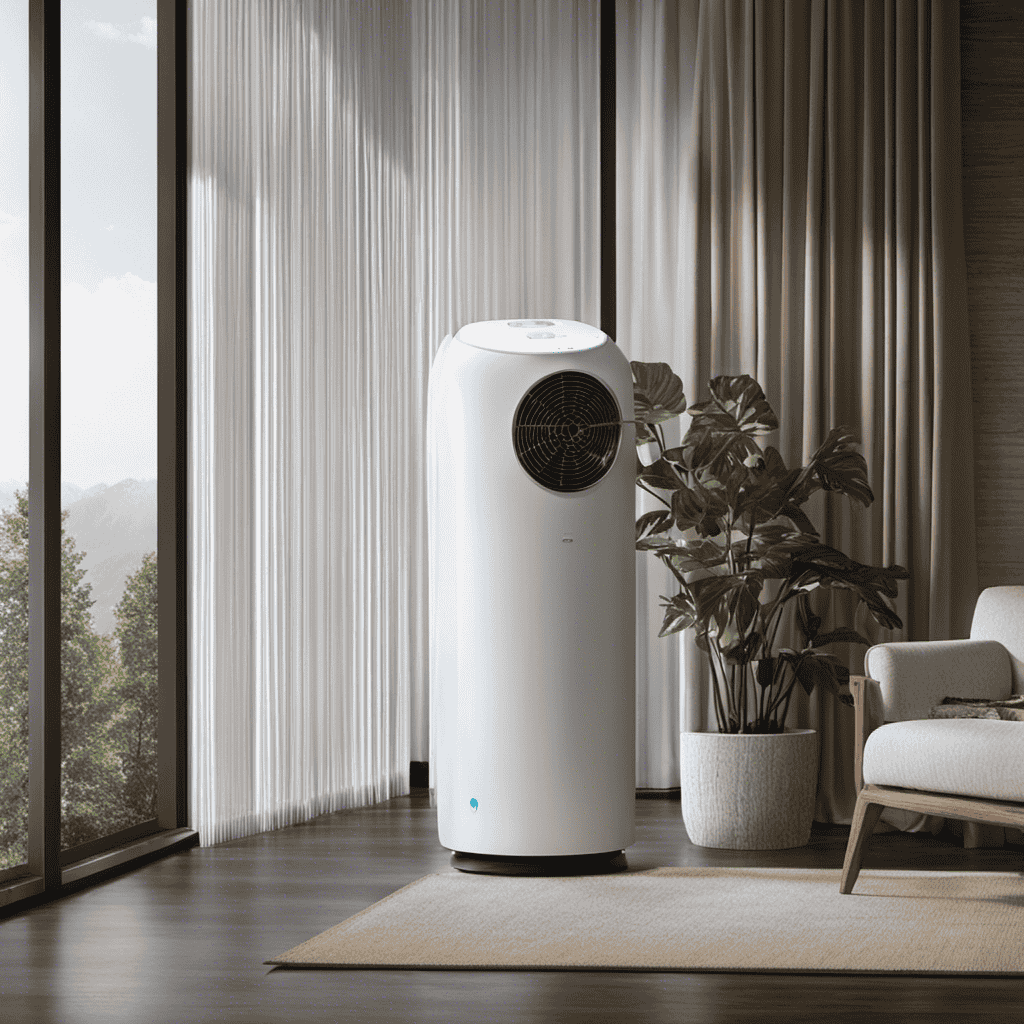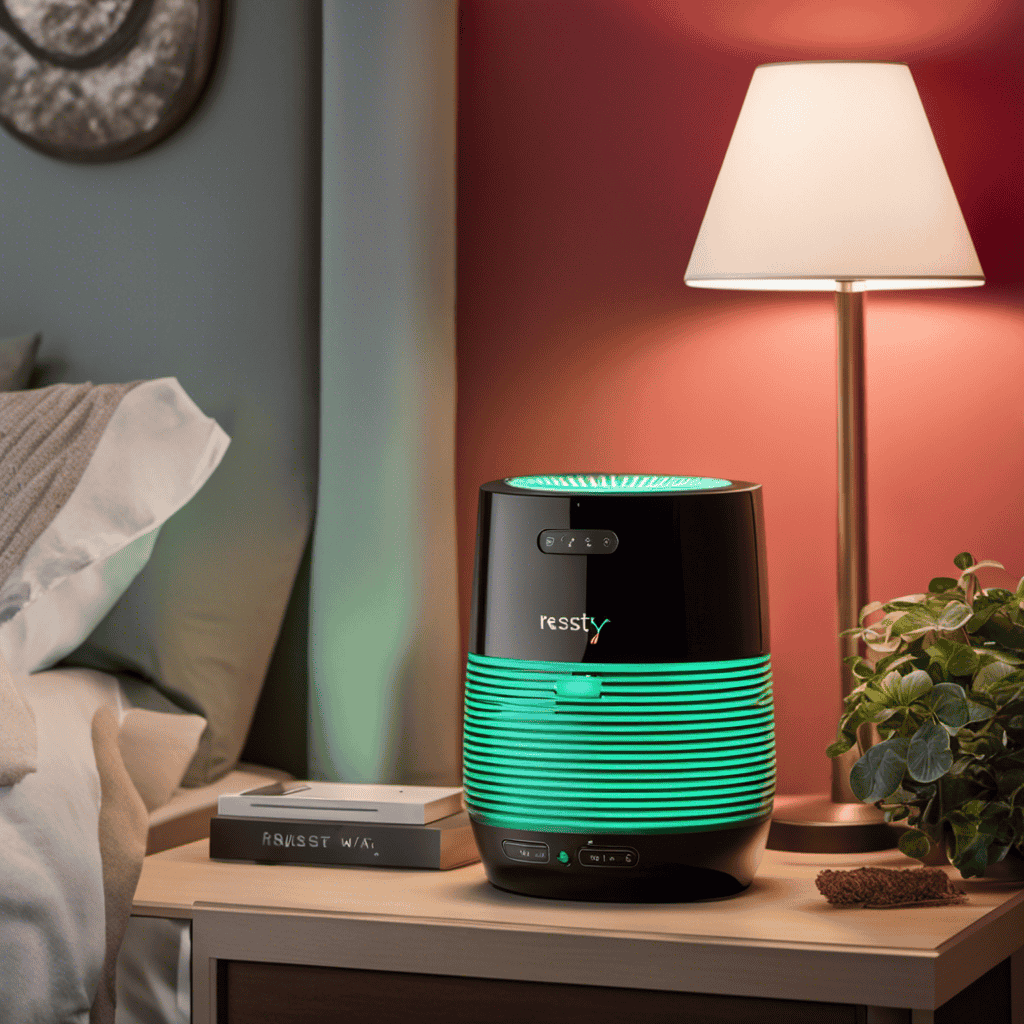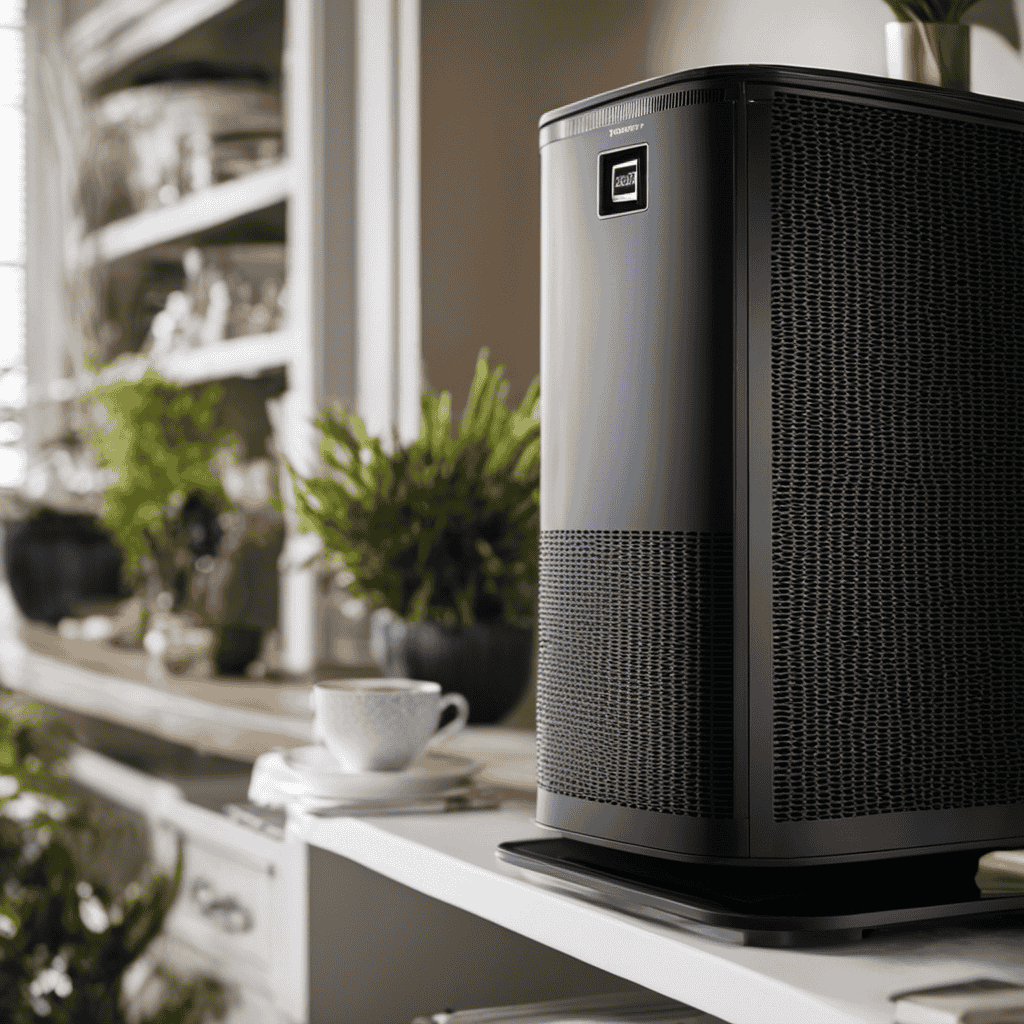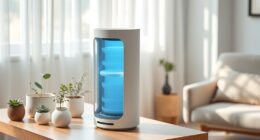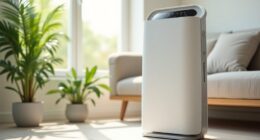I enjoy the sensation of having fresh, clean air in my house. It’s important to regularly maintain the filters of my Honeywell QuietClean® Tower Air Purifier to guarantee I keep breathing in that refreshing, purified air.
In this article, I will guide you through the step-by-step process of cleaning the filters, providing you with the tools and materials needed, as well as tips for proper maintenance.
Say goodbye to dust and allergens, and say hello to a healthier living space. Let’s get started!
Key Takeaways
- Regular filter cleaning is important for optimal performance of the Honeywell Quietclean® Tower Air Purifier.
- Cleaning the filters improves indoor air quality by removing dust, pollen, and allergens.
- Proper maintenance of filters, including vacuuming or washing with warm soapy water, is essential for longevity and efficiency.
- Filters should be cleaned every 3 months to ensure the longevity and effectiveness of the air purifier.
Understanding the Importance of Filter Cleaning
Understanding the importance of filter cleaning is crucial for maintaining the performance of the Honeywell QuietClean® tower air purifier. Regular filter cleaning not only ensures that the air purifier functions optimally, but also improves indoor air quality by removing dust, pollen, pet dander, and other allergens from the air. By cleaning the filters regularly, you can prevent the build-up of these particles, which can clog the filters and reduce their effectiveness.
Additionally, clean filters promote better airflow, allowing the air purifier to circulate and purify the air more efficiently. This ultimately leads to a healthier and more comfortable living environment.
Now, let’s discuss the tools and materials needed for filter cleaning.
Tools and Materials Needed for Filter Cleaning
When it comes to maintaining the efficiency of my Honeywell QuietClean® Tower Air Purifier, proper cleaning techniques and frequency of filter cleaning are crucial.
To ensure optimal performance, I have found that using a soft brush or vacuum attachment to gently remove dust and debris from the filters works best.
Additionally, I make it a point to clean the filters at least once every three months to prevent clogging and maintain clean air in my living space.
Proper Cleaning Techniques
To properly clean the filters of your Honeywell QuietClean® tower air purifier, you’ll need to follow these techniques. The cleaning frequency for the filters depends on the air quality and usage of the purifier. For optimal performance, it is recommended to clean the filters every 3 months. Here are the effective cleaning techniques for the different types of filters in the air purifier:
| Filter Type | Cleaning Technique |
|---|---|
| Pre-Filter | Vacuum or wash with warm soapy water |
| HEPA Filter | Vacuum or wash with warm soapy water |
| Odor-Reducing Filter | Replace every 3 months |
Make sure to turn off and unplug the air purifier before cleaning the filters. Gently remove the filters and follow the cleaning techniques mentioned above. Allow the filters to dry completely before reinstalling them. Regularly cleaning the filters will ensure the longevity and efficiency of your Honeywell QuietClean® tower air purifier.
Frequency of Filter Cleaning
The recommended cleaning frequency for the filters in the Honeywell QuietClean® tower air purifier depends on the air quality and usage. Regular cleaning is of utmost importance to ensure optimal performance and maintain the efficiency of the air purifier.
By cleaning the filters regularly, you can remove dust, pollen, pet dander, and other airborne particles that can accumulate over time. Clean filters also help to improve the indoor air quality, reducing allergens and odors in your living space.
Additionally, clean filters ensure that the air purifier operates at its best, effectively capturing and trapping pollutants. To maintain the cleanliness of your filters, follow a step-by-step guide to removing and cleaning them properly, ensuring the longevity and effectiveness of your Honeywell QuietClean® tower air purifier.
Step-by-Step Guide to Removing the Filters
Proper filter maintenance is essential for ensuring the optimal performance and longevity of your air purifier. In this discussion, I’ll explain the cleaning techniques that should be followed to effectively remove dirt, dust, and other particles from the filters of your Honeywell QuietClean® Tower Air Purifier.
Proper Filter Maintenance
Make sure you regularly clean the filters of your Honeywell QuietClean® tower air purifier to maintain its proper functioning. Understanding the benefits of proper filter maintenance is essential in ensuring clean and fresh air in your home.
By cleaning the filters regularly, you can remove trapped particles such as dust, pollen, and pet dander, improving the air quality and reducing the risk of allergies and respiratory issues.
However, there are common mistakes that people often make when it comes to filter maintenance. Some may forget to clean the filters regularly, while others may not clean them properly, leading to inefficient filtration and decreased performance of the air purifier.
To avoid these mistakes, it is important to follow the correct cleaning techniques as explained in the subsequent section.
Cleaning Techniques Explained
To ensure efficient filtration and optimal performance, it’s important to follow the correct cleaning techniques as explained in the subsequent section.
Regular cleaning of the Honeywell QuietClean® tower air purifier filters is vital for maintaining its effectiveness and prolonging its lifespan.
One common mistake to avoid is neglecting to clean the filters regularly. Over time, dust and other particles accumulate on the filters, reducing their ability to trap airborne contaminants.
Another mistake is using harsh chemicals or abrasive cleaning methods. This can damage the filters and compromise their filtration capability. Instead, it is recommended to gently vacuum the filters or rinse them with water to remove the accumulated dirt and debris.
Allow the filters to dry completely before reinstalling them.
Following these cleaning techniques will ensure that your Honeywell QuietClean® tower air purifier continues to provide clean and fresh air in your space.
Proper Maintenance Tips for Extending Filter Lifespan
Regularly cleaning the filters of the Honeywell QuietClean® tower air purifier can help extend their lifespan. To ensure proper maintenance and maximize filter performance, it is essential to follow proper storage techniques and troubleshoot common filter cleaning issues.
When storing the filters, it is crucial to keep them in a clean and dry environment. Avoid exposing them to excessive heat or extreme temperatures, as this can damage their effectiveness. Additionally, store the filters in a sealed bag or container to prevent dust and debris from accumulating.
In case of common filter cleaning issues, such as stubborn dirt or clogged particles, a gentle vacuuming or rinsing with lukewarm water can effectively remove the debris. However, always refer to the product manual for specific cleaning instructions to avoid any potential damage to the filters.
How Often Should You Clean the Filters
If you want to maintain optimal performance, it’s important to clean the filters of your Honeywell QuietClean® tower air purifier on a regular basis. Not only will this ensure the air purifier continues to effectively remove airborne particles, but it will also extend the lifespan of the filters.
Here are some signs that your filters need cleaning:
- Reduced airflow: If you notice that the air purifier is not circulating air as efficiently as before, it may be due to clogged filters.
- Visible dirt or debris: Inspect the filters visually for any accumulation of dirt, dust, or other particles.
- Unpleasant odor: If you detect a musty or stale smell coming from the air purifier, it could be a sign that the filters need cleaning.
- Increased noise level: A dirty filter can cause the air purifier to work harder, resulting in louder operation.
- Decreased effectiveness: If you notice that your allergies or respiratory symptoms are worsening, it may be time to clean the filters.
To clean the different types of filters in your Honeywell QuietClean® tower air purifier, follow these steps:
-
Pre-filter: Remove the pre-filter and gently vacuum or brush off any loose dust or debris. If needed, rinse the pre-filter under running water and let it dry completely before reinstalling.
-
HEPA filter: Depending on the model, the HEPA filter may not be washable. Check the user manual for specific instructions. If washable, rinse the filter under running water until the water runs clear. Allow the filter to air dry completely before reinserting.
-
Odor-reducing pre-filter (optional): If your air purifier has an odor-reducing pre-filter, replace it according to the manufacturer’s guidelines.
-
Carbon filter (optional): If your air purifier has a carbon filter, replace it according to the manufacturer’s guidelines.
-
Electronic filter indicator: Some Honeywell air purifiers have electronic filter indicators that will alert you when it’s time to clean or replace the filters. Follow the instructions provided by the manufacturer to reset the indicator after cleaning or replacing the filters.
Cleaning the Pre-Filter: A Detailed Process
Cleaning the pre-filter in your Honeywell air purifier is a simple process. It involves removing any loose dust or debris and rinsing it under running water if necessary. Regular cleaning of the pre-filter is important to maintain the efficiency and performance of your air purifier. A clean pre-filter provides several benefits.
Improved air flow: A clean pre-filter allows for better air circulation, ensuring that your air purifier can effectively filter the air in your space.
Increased lifespan of the HEPA filter: By removing larger particles such as pet hair and dust, the pre-filter helps to prevent these particles from clogging the HEPA filter. This can extend the lifespan of the HEPA filter and save you money on replacements.
Better removal of large particles: The pre-filter is designed to capture larger particles, such as pet hair and dust. By keeping the pre-filter clean, you ensure that these particles are effectively removed from the air.
To clean the pre-filter, follow these steps:
- Turn off and unplug the air purifier.
- Open the front cover and remove the pre-filter.
- Gently tap it to remove any loose dust, or rinse it under running water if needed.
- Allow the pre-filter to air dry completely before reinstalling it.
With a clean pre-filter, your Honeywell air purifier will continue to provide you with clean and fresh air.
Next, let’s discuss the process of deep cleaning the HEPA filter and what you need to know.
Deep Cleaning the HEPA Filter: What You Need to Know
Now, let’s dive into the process of deep cleaning the HEPA filter and what you’ll need to know.
Cleaning your HEPA filter is essential to maintain the efficiency and effectiveness of your Honeywell QuietClean® Tower Air Purifier. Here are some important deep cleaning techniques to keep in mind:
- Start by turning off the air purifier and unplugging it from the power source.
- Remove the HEPA filter from the unit according to the manufacturer’s instructions.
- Gently vacuum the filter to remove any loose dirt and debris.
- Fill a basin with warm water and mild detergent, and then soak the filter for about 15 minutes.
- Rinse the filter thoroughly with clean water and let it air dry completely before reinstalling.
Regularly deep cleaning your HEPA filter has numerous benefits, including improved air quality, increased lifespan of the filter, and better overall performance of your air purifier.
It’s crucial to follow these cleaning techniques to ensure optimal functioning of your Honeywell QuietClean® Tower Air Purifier.
Tips for Cleaning the Carbon Activated Filter
Now that we’ve covered deep cleaning the HEPA filter, let’s move on to another essential component of the Honeywell QuietClean® Tower Air Purifier: the carbon activated filter. This filter plays a crucial role in removing odors and harmful gases from the air, ensuring a fresh and clean environment. To maintain optimal performance, it’s important to regularly clean the carbon filter using proper cleaning techniques. Here are some tips for carbon filter maintenance:
- Gently vacuum the filter to remove surface dust and debris.
- Wash the filter with warm water and a mild detergent solution.
- Rinse thoroughly and allow it to air dry completely before reinstalling.
- Avoid using harsh chemicals or abrasive materials that could damage the filter.
- Follow the manufacturer’s instructions for filter replacement intervals to ensure continued effectiveness.
By implementing these cleaning techniques and staying on top of carbon filter maintenance, you can enjoy the full benefits of your Honeywell QuietClean® Tower Air Purifier while breathing cleaner, fresher air.
| Cleaning Techniques | Carbon Filter Maintenance |
|---|---|
| Gently vacuum the filter | Regularly clean the filter |
| Wash with warm water and mild detergent solution | Follow manufacturer’s replacement intervals |
| Rinse thoroughly and air dry | Avoid harsh chemicals and abrasives |
Reinstalling the Filters: Ensuring Proper Placement
When reinstalling the filters, make sure they are properly placed for optimal performance. It is crucial to follow the correct procedure to ensure that the filters are aligned correctly and securely.
Here are some important steps to troubleshoot filter placement:
- Check for any debris or obstructions in the filter slots before inserting the filters.
- Align the arrows or tabs on the filters with the corresponding slots in the air purifier.
- Gently push the filters into place until they are snugly fitted.
- Double-check that the filters are securely seated and there are no gaps or loose edges.
- Finally, ensure that the front panel is properly closed and latched to maintain a sealed filtration system.
Frequently Asked Questions
How Long Does It Take to Clean the Filters of the Honeywell Quietclean® Tower Air Purifier?
I clean the filters of the Honeywell Quietclean® Tower Air Purifier every 3 months. Regularly cleaning the filters ensures optimal performance and improves air quality by removing dust, allergens, and other particles.
Can I Use a Vacuum Cleaner to Clean the Filters?
Yes, you can use a vacuum cleaner to clean the filters of the Honeywell Quietclean® Tower Air Purifier. However, there are alternative cleaning methods available that may be more effective and thorough.
Are the Filters of the Honeywell Quietclean® Tower Air Purifier Washable?
Yes, the filters of the Honeywell Quietclean® Tower Air Purifier are washable. However, it is important to note that bleach should not be used to clean the filters and a hairdryer should not be used to dry them.
Can I Use a Cleaning Solution to Clean the Filters?
Yes, you can use a cleaning solution to clean the filters of the Honeywell Quietclean® Tower Air Purifier. However, it is recommended to follow the manufacturer’s instructions and use DIY methods to clean the filters.
Is It Necessary to Replace the Filters if They Are Not Cleaned Regularly?
Regular cleaning of the filters is necessary to maintain optimal performance. If not cleaned regularly, the filters may become clogged and less effective at removing airborne particles. Replacement filters can be used as an alternative to cleaning.
Conclusion
In conclusion, it is essential to maintain the cleanliness of your Honeywell QuietClean® Tower Air Purifier filters for optimal performance. Just like a well-tuned engine, these filters require regular care to effectively remove airborne pollutants from your indoor environment.
By following the step-by-step guide we provided, using the right tools and materials, and implementing proper maintenance tips, you can extend the lifespan of your filters and enjoy cleaner, fresher air.
Remember, a well-maintained filter is the key to unlocking the full potential of your air purifier’s purification capabilities.

